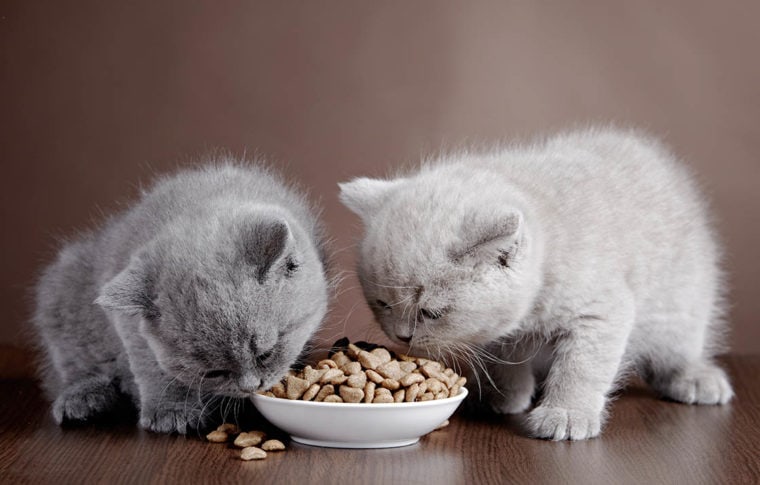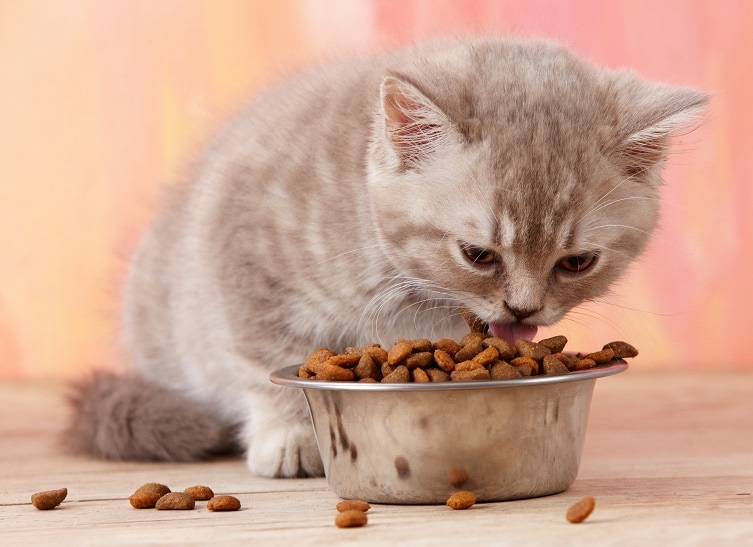
You’re the proud parent of an adorable fur ball and are now wondering at what age they will be able to chew solid and dry food. Generally, kittens start the weaning process at around 4 weeks of age, starting with soft food and transitioning to dry food by 7-8 weeks of age.
Read on to learn how to ease your kitten’s transition to regular dry food!
When Can Kittens Start Eating Dry Food?
During their first 4 weeks of life, newborn kittens receive all the nutrients that they need from their mother’s milk, or kitten replacement milk formula if they are being hand-reared.
Weaning starts from around 4 weeks of age but it is usually best to start with wet kitten food with added water or kitten milk replacer. Once they have gotten the hang of the wet food, they can move on to soaked dry food, gradually decreasing the amount of water mixed with the kibble over time. By 7- 8 weeks they can usually be transitioned completely onto dry kibble if preferred. Most mother cats nurse their kittens until they are 6 to 8 weeks old.
Always make sure fresh water is available for the kittens to drink.

Should Kittens Eat Dry or Wet Food First?
Keep in mind that very small kittens are unable to chew dry food due to their tiny teeth and jaws. Therefore, they must have access to wet food to meet their nutritional needs when they start the weaning process. Wet food also has the advantage of a high water content, which helps keep the kittens hydrated and healthy.
In contrast, dry food is generally more economical and can be left in a bowl for long periods without fear of waste. However, it can be difficult to keep track of portions, especially if you leave a bowl full of food available to your kitten at all times. They may overeat and gain weight, which can lead to a host of health problems.
If you are unsure which option to give your kitten, ask your veterinarian for advice. As long as you are feeding a balanced complete diet, they can of course have a mixture of both dry and wet food.
Whether you are an avid kibble supporter, favor wet food, or dabble between the two, opting for the right cat bowl to serve it in is key! The Hepper NomNom Cat Bowl is equipped with features like shallow dishes for whisker relief, slight elevation to promote good posture and digestion, and removable stainless steel bowls for easy cleaning. Its modern design is spill-proof and has a wide tray on the base meant to catch anything that falls from your kitty's mouth or out of the bowl. Click here to find out if the Hepper NomNom Cat Bowl is right for you.
At Pet Keen, we’ve admired Hepper for many years and decided to take a controlling ownership interest so that we could benefit from the outstanding designs of this cool cat company!
How Much Dry Food Should You Give Your Kitten?
In general, the suggested portions based on age on dry food packages are good guidelines.
Young kittens need to eat little and often, 3-4 times a day. You can also provide them with an unlimited amount of kitten food throughout the day, then switch to meals at specific times when they are around 4 to 6 months of age. However, this type of “free feeding” is not always the best option, as it can lead to excess weight.

Is Cat Food That’s Designed for All-Life Stages Okay for Kittens?
It depends. Some cat food manufacturers design diets for all life stages, which are supposed to meet the nutritional needs of cats, whether they are still young, growing kittens, or fully fledged adults.
However some experts warn against this type of “general” food because the nutritional needs of kittens are different from those of adults, for example, they need higher amounts of proteins, amino acids, and minerals. Therefore, we recommend feeding your kitten exclusively foods specially formulated for them. Ideally, choose a high-quality kitten food that meets the AAFCO (American Association of Feed Controls Officials) nutrient profile standards for kittens- check the label for the ‘AAFCO Statement’.
When to Switch to Adult Cat Food
Around 12 months of age, your kitten can switch to high-quality adult cat food. However, this change in diet must be done gently to prevent your kitten from suffering from gastrointestinal discomfort. It’s best to make the transition throughout 7 to 10 days, starting by mixing a small amount of the new adult food with the usual kitten food.
Conclusion
Kittens can start eating dry food around 6 to 8 weeks of age. However, you can start this transition to solid food by giving wet canned food to your kitten first. As they get used to eating solid food and their teeth continue to develop, gradually add dry food mixed with water.
Above all, do not hesitate to ask your veterinarian for advice if your kitten refuses to eat solid food or if the transition does not go as planned.
See Also:
- How to Transition a Cat to a Raw Food Diet: 10 Vet-Approved Tips
- How Do Cats Communicate With Each Other? Vet-Reviewed Feline Language Guide
Featured Image Credit: MaraZe, Shutterstock








